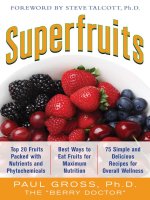Superfruits: (Top 20 Fruits Packed with Nutrients and Phytochemicals, Best Ways to Eat Fruits for Maximum Nutrition, and 75 Simple and Delicious Recipes for Overall Wellness) pdf
Bạn đang xem bản rút gọn của tài liệu. Xem và tải ngay bản đầy đủ của tài liệu tại đây (3.3 MB, 241 trang )
Advance Praise for Superfruit s
“Paul Gross’s straightforward and well-documented book provides strong
direction and clear-cut answers for consumers, based on well-reasoned
research and compelling evidence. His use of . . . superfruits criteria and
a ‘points system’ for rating health-bene cial fruits is a welcome answer
to consumers seeking the best choices for themselves and their families.”
—Mary Ann Lila Ph.D., director, Plants for Human Health Institute,
North Carolina State University
“Paul Gross, the ‘Berry Doctor,’ goes beyond the marketing hype on super-
fruits, using an easy-to-understand method of ranking potential stars. By
looking at nutrient density, research support, and popular appeal, Gross
delivers a cornucopia of o erings that can easily enhance well-being . . .
whether via simple suggestions in the breakdown of each o ering, a list
of the types of products to look for in the supermarket, or by following
the creative recipes from the back of the book.”
—Heather Granato, group editor, Virgo Publishing
“ is is a book for the public, for nutritionists, M.D.s, alternative medical
practitioners, vegetarians—for anyone who wants to better understand
what a well-chosen selection of superfruits can do for you inside and out
besides tasting great.”
—Ian Crown, Panoramic Fruit Company, Puerto Rico
“Dr. Gross is a leading expert and strong proponent of consumer educa-
tion and superfruit science, and following careers as a university scientist,
entrepreneur, and food industry consultant, he is the leading advocate
for superfruits and superfruit science.”
—Steve Talcott Ph.D., Department of Food Chemistry, Texas
A&M University
This page intentionally left blank
PAUL GROSS, Ph.D.
THE “BERRY DOCTOR”
S
u
p
e
r
f
r
u
i
t
s
S
u
p
e
r
f
r
u
i
t
s
New York Chicago San Francisco Lisbon London Madrid Mexico City
Milan New Delhi San Juan Seoul Singapore Sydney Toronto
Copyright © 2010 by The McGraw-Hill Companies, Inc. All rights reserved. Except as permitted
under the United States Copyright Act of 1976, no part of this publication may be reproduced or
distributed in any form or by any means, or stored in a database or retrieval system, without the prior
written permission of the publisher.
ISBN: 978-0-07-163505-9
MHID: 0-07-163505-X
The material in this eBook also appears in the print version of this title: ISBN: 978-0-07-163387-1,
MHID: 0-07-163387-1.
All trademarks are trademarks of their respective owners. Rather than put a trademark symbol after
every occurrence of a trademarked name, we use names in an editorial fashion only, and to the
benefit of the trademark owner, with no intention of infringement of the trademark. Where such
designations appear in this book, they have been printed with initial caps.
McGraw-Hill eBooks are available at special quantity discounts to use as premiums and sales
promotions, or for use in corporate training programs. To contact a representative please e-mail us at
The information contained in this book is intended to provide helpful and informative material on the
subject addressed. It is not intended to serve as a replacement for professional medical advice. Any
use of the information in this book is at the reader's discretion. The author and publisher disclaim any
and all liability arising directly or indirectly from the use or application of any information contained
in this book.
TERMS OF USE
This is a copyrighted work and The McGraw-Hill Companies, Inc. (“McGraw-Hill”) and its
licensors reserve all rights in and to the work. Use of this work is subject to these terms. Except as
permitted under the Copyright Act of 1976 and the right to store and retrieve one copy of the work,
you may not decompile, disassemble, reverse engineer, reproduce, modify, create derivative works
based upon, transmit, distribute, disseminate, sell, publish or sublicense the work or any part of it
without McGraw-Hill’s prior consent. You may use the work for your own noncommercial and person-
al use; any other use of the work is strictly prohibited. Your right to use the work may be terminated
if you fail to comply with these terms.
THE WORK IS PROVIDED “AS IS.” McGRAW-HILL AND ITS LICENSORS MAKE NO GUAR-
ANTEES OR WARRANTIES AS TO THE ACCURACY, ADEQUACY OR COMPLETENESS OF
OR RESULTS TO BE OBTAINED FROM USING THE WORK, INCLUDING ANY INFORMA-
TION THAT CAN BE ACCESSED THROUGH THE WORK VIA HYPERLINK OR OTHERWISE,
AND EXPRESSLY DISCLAIM ANY WARRANTY, EXPRESS OR IMPLIED, INCLUDING BUT
NOT LIMITED TO IMPLIED WARRANTIES OF MERCHANTABILITY OR FITNESS FOR A
PARTICULAR PURPOSE. McGraw-Hill and its licensors do not warrant or guarantee that the
functions contained in the work will meet your requirements or that its operation will be
uninterrupted or error free. Neither McGraw-Hill nor its licensors shall be liable to you or anyone else
for any inaccuracy, error or omission, regardless of cause, in the work or for any damages resulting
therefrom. McGraw-Hill has no responsibility for the content of any information accessed through the
work. Under no circumstances shall McGraw-Hill and/or its licensors be liable for any indirect,
incidental, special, punitive, consequential or similar damages that result from the use of or inability
to use the work, even if any of them has been advised of the possibility of such damages. This limita-
tion of liability shall apply to any claim or cause whatsoever whether such claim or cause arises in
contract, tort or otherwise.
v
Contents
FOREWORD by Steve Talcott, Ph.D. vii
ACKNOWLEDGMENTS xi
INTRODUCTION Welcome to the World of Superfruits! 1
PART I Superfruits for Long-Term Wellness
1 Essential Nutrients and Superfruit Signatures
2 Superfruit Phytochemicals
and the Health Value of Colors
PART II The Superfruits
3 Nature’s Top Twenty Superfruits
PART III Superfruits in Action
4 Superfruits in Your Shopping Cart
5 Superfruits in Your Daily Diet
6 Superfruit Recipes
vi CONTENTS
APPENDIX A Scientifi c Foundation Behind
Superfruit Antioxidants 197
APPENDIX B Superfruits with Edible Seeds 203
APPENDIX C Ten Superfruit Candidates for the Future 205
APPENDIX D Bibliography, References, and Author’s
Other Publications 213
INDEX 221
vii
Foreword
I
great privilege to work in the world of fruits and, each
day, conduct research trials on fruits harvested from locations both
near and far. When I think of people eating fruit, I have a mental image of
warm, happy days, smiles on faces, and looks of pure enjoyment. I expe-
rience this sense of pleasure daily with my own family in our frequent
trips to the community fruit bowl or our well-stocked refrigerator lled
with seasonal and nonseasonal fruits and juices. A quick look around
your local supermarket will readily reveal that the fruits and juices of
our childhood memories have changed. We now have new, improved,
and exotic products to choose from, many claiming to be “super” good
for you. e choices can be overwhelming—and, a er all, what does an
açaí berry, goji berry, or blackcurrant taste like, and should I spend my
hard-earned money to buy it?
is all leads to a valid and thought-provoking question: Are all fruits
created equal, or are some fruits created “super”? If there are indeed
“superfruits,” can we apply logic and infer that there are also “not-so-
super” fruits?
As a food chemist, I conduct research on phytochemical compounds
in fruits responsible for their color, avor, and potential health bene ts.
I know that all fruits inherently contain some level of nutrients, that not
all varieties of the same fruits are the same, and that all contain at least
some nonnutrient compounds known as phytochemicals that may con-
tribute directly or indirectly to our overall health and wellness. To use a
viii FOREWORD
simple analogy: as someone who works with many di erent fruits, decid-
ing between super or not-super fruits is like asking a mother to choose
a favorite from among her children. So, when it comes to fruits, we need
to realize that each one has something unique to o er our palates and
our bodies. ose unique properties may be energy, a preferred taste or
aroma, dietary ber, hunger, satiety, or what we hope will be a positive
bene t on our overall health.
What, then, is a “superfruit,” and why do we see so many fruits that
seemingly compete for the right to be called “super”? e reality is that
most scientists do not use the term superfruit or superfood, but rather
these terms came to international prominence via a route that bypassed
the research laboratory or government regulatory agency. ere is noth-
ing inherently wrong with the term superfruit; as consumers, we are
o en persuaded to purchase products based on a well-conceived mar-
keting program. Simply put, from time to time, nature gives us fruits
in abundance that science can de ne as superior to others in delivering
both nutrient and nonnutrient compounds.
A browse through your local supermarket or specialty foods store
over the past years has no doubt been an adventurous endeavor. Unless
you reside in a major metropolitan area or spend extensive time trav-
eling abroad, your earlier experience with fruits such as pomegranate,
mango, açaí, goji berry, mangosteen, and papaya was likely quite limited,
yet in today’s superfruit world you can enjoy these fruits routinely, and
o en in various formats—fresh, juiced, dried, or blended into beverages.
e marketing messages from these fruits can also be overwhelming and
may be based on an exaggeration of the limited research studies con-
ducted on the actual fruit. As an upshot, consumers are now accustomed
to mention of such obscure substances as antioxidants, polyphenolics,
carotenoids, anthocyanins, omega- fatty acids, and resveratrol, which
are used as buzzwords to gain market attention and hold consumer
interest.
As a fruit scientist, I readily admit that we know far too little about
the direct health bene ts of fruit consumption, not to mention those
fruits categorized as superfruits, but fortunately for us all, Dr. Paul Gross
has taken on the daunting challenge to reveal the elusive world of super-
FOREWORD ix
fruits in this entertaining and informative book. Dr. Gross is a leading
expert and strong proponent of consumer education and superfruit sci-
ence, and following careers as a university scientist, entrepreneur, and
food industry consultant, he is the leading advocate for superfruits and
superfruit science. A ectionately referred to as “the Berry Doctor,” Dr.
Gross has educated countless people, including scientists and medical
professionals, on the richness and bene ts that superfruits bring to our
lives.
In this book, Dr. Gross will take you through a set of ve simple cri-
teria that he uses to create a ranked list of twenty fruits to which he refers
as nature’s top superfruits. He freely admits that no one fruit will provide
all of the nutrients that our bodies need, yet he shows us that consuming
whole foods (and lots of them) can be one of the most important con-
tributing aspects of a healthy lifestyle. His inclusion criteria were wisely
established based on factors such as nutrient and nonnutrient content,
biomedical research, and the ability to eventually le for government-
approved health claims, as well as critical subjective qualities, such as
packaging, avor, a ordability, and availability to the consumer.
e last point I want to make regarding fruits, vegetables, and even
superfruits is that the only way to gain their bene ts is to actually con-
sume them. Trends from around the world show few positive changes
in the overall health status of populations and indicate that our diets are
still lacking in su cient intake of fruits, vegetables, and whole grains.
I concede that there is no simple solution to our dietary inadequacies
and that consuming superfruits may be an answer to this dilemma. Per-
haps the “Age of the Superfruit” is now upon us, and superfruits have
the ability to o er novelty, diversity, and intrigue to encourage healthier
lifestyles and dietary habits.
S T, P.D.
Associate Professor of Food Chemistry
Texas A&M University
This page intentionally left blank
xi
Acknowledgments
C
came from my experiences as a youth in
Chatham, Ontario, Canada, overlapped with American and British
university education, research training, and professional development as
a health scientist. Life lessons from all three countries led to my interest
in nutrition, phytochemicals, and how “super” fruits can o er a solution
for healthier dietary practices.
Special thanks to Fiona Sarne of McGraw-Hill, for her vision of the
book’s place in the public, streamlined editing, and e cient organization
of resources; Ian Crown of Stamford, Connecticut, and Panoramic Fruit
Company, Puerto Rico, for years of good humor and entertaining educa-
tion through the eyes of a fruit horticulturalist; and Steve Talcott, Ph.D.,
of Texas A&M University, for challenging my ideas, critiquing early
dra s, and providing active research leadership in superfruit science.
This page intentionally left blank
1
Introduction
Welcome to the World of Superfruits!
I
years, the word superfruit has blared into the head-
lines with alluring fanfare. What began as just a few curious exotic
juices in the American market has now evolved into thousands of prod-
ucts in a multibillion-dollar global industry. From the start, the super-
fruit category has been more about marketing than science. Beverages
made from rare, enchanting fruit species marketed with a message of
antioxidant bene ts have beckoned consumers with a seductive array of
irresistible health promises.
e truth is that some fruits proposed as “super” really aren’t, and no
claims about antioxidant health bene ts from fruits are actually estab-
lished by science or allowed by regulatory authorities. I’m going to expose
some misconceptions about this expanding category of superfoods and
give you a list of twenty fruits that are actually super based on nutritional
facts and scienti c criteria. I’ll share with you how these twenty super-
fruits can be easily added to your diet, not just because they are delicious,
but also for their nutrient properties—scienti cally proved to have the
potential for lowering your risk of contracting major diseases.
is book stems from my teaching and research career in physiolo-
gy—the branch of biological sciences specializing in how organs of the
body work together moment by moment throughout life. is pursuit
demands an understanding of how foods are digested to supply essential
2 INTRODUCTION
nutrients, which are then circulated via the blood to nourish all of the
body’s organs and cells. Nutrient-rich whole superfruits can give your
body a headstart for making this process e cient and easy to repeat
through practice of a healthy diet over all years of your life.
As a physiologist, I am also interested in why organs fail and disease
develops. Having been a research director in a university hospital surgery
department and cofounder of a clinical trials management company, I
have been close enough to major diseases to know that many are prevent-
able by healthy living practices, including the right nutritional content and
amount of food. In nearly every developed country today, however, there is
a spiraling trend of obesity and its constellation of associated diseases such
as chronic in ammation and pain, diabetes, blood and cardiovascular dis-
orders, psychological illnesses, and even several types of cancer—many of
these related to poor nutritional content and excessive food intake.
is book will show you how to use superfruits as delicious, whole-food
sources of essential nutrients your body requires for general well-being.
The Truth About Superfruit Juices
By my de nition, superfruits should be all about sustaining regular
healthy intake of nutrients from whole foods, not processed, blended, and
diluted juices—a de nition that may be surprising to you. Did you know
that most of the juices that stimulated the concept of superfruits are
highly processed so that there is little le in them except color and taste?
ey are marketed on myths of ancient uses for unproved health bene ts,
not on the nutrient value of the natural fruit that this book emphasizes.
You may have come to this book looking for insights about exotic
fruits renowned as top antioxidant superfruit juices. is subject will be
addressed but perhaps with unexpected truths. e base of science for
most existing superfruit products has not been adequately explained,
leaving a knowledge gap between actual fruit compounds in the product
and the health value expected from them. We’re going to get the facts
about superfruits straight in this book!
My message is that superfruits should be your constant reminder and
daily source of nutrients. Contrary to the way superfruits are marketed
currently—as antioxidant-rich juices—this book is about whole fruits
WELCOME TO THE WORLD OF SUPERFRUITS! 3
truly superior due to their natural high density of scienti cally estab-
lished nutrients essential for maintaining health.
What About Pills or Supplements as
Substitutes for Superfruits?
ere will always be someone looking for a simpler solution. I’ve heard it
many times: “Why not devise a pill or just a scoop of powder that contains
all those nutrients and interesting phytochemicals from a few of your favor-
ite superfruits? Wouldn’t that be a popular product in the diet world?”
In the industry of nutraceuticals—extracts from natural sources
thought to have a bene cial e ect—quite a few manufacturers actually
take on this challenge and make a supplement of green or purple powder
that supposedly simpli es food intake into a single serving. As a propo-
nent of a whole-food diet, I have a few thoughts about such products that
challenge this logic:
How do you know that the proportions of nutrients and phy-
▶
tochemicals in the whole natural superfruit are preserved?
e phytochemical “synergy,” as discussed in Part I, is compromised
▶
by processing a whole fruit into a pill or powder. e manufacturer
makes the choice about which nutrients to include. Can it be better
than nature has done in whole superfruits? I say no.
One of the superfruit signature nutrients with broad health e ects—
▶
prebiotic dietary ber (also called soluble or viscous ber)—is manu-
factured out of nearly every pill or capsule, unless purposely put back
in. Don’t miss out on the important health values of prebiotic ber.
Superfruits not only are highly nutritious and enjoyable to eat but
▶
also furnish calories for your energy needs during the day. Giving
that up for the convenience of a pill or supplement defeats a pur-
pose for consuming whole foods—obtaining calories for our day’s
physical activity needs.
ere are undeniable pleasures in eating whole foods—their fra-
▶
grance, taste, juiciness, crunch, and feeling of freshness—that pills
and powders can never match.
Cost: why deny all of the foregoing bene ts for a pill or powder at a
▶
price usually higher than the natural whole superfruit?
4 INTRODUCTION
FIBER FACTS
Fiber unfortunately has several names that may easily lead to confusion.
As fruits are excellent fi ber sources, let’s try to make this clear. Soluble
fi ber (mainly from fruit pulp long-chain sugars called poly- or oligosac-
charides) is the same as prebiotic or viscous fi ber that remains undigested
until it reaches the colon where it becomes food for the “good” bacteria in
your lower intestine (therefore, supplying a prebiotic function). Insoluble
fi ber (from fruit skins, pith, or coats of edible seeds) is not digested but
attracts water to ease the passage of food through the digestive system.
How Do Fruits Earn “Super” Status?
So, what is it that sets superfruits apart from regular fruits or currently
marketed superfruit juices? I believe it’s an optimal mix of natural fruit
compounds—nutrients and phytochemicals—that should be in every-
one’s diet.
My choices of top superfruits come by looking in each fruit for nat-
ural nutrient groups: () the antioxidant vitamins A (from plant com-
pounds called carotenoids), C, and E; () B vitamins; () essential dietary
minerals; () amino acids and protein; () dietary ber, both soluble and
insoluble; () omega fats; and () phytosterols. ese are natural nutrients
for growth of the fruit itself—how it was designed in nature throughout
evolution—that are known from modern physiological studies on diets
to be essential to human health. Any whole fruit containing them all in
rich amounts would indeed be super!
Also included among my valued superfruit characteristics are two
classes of nonnutrient phytochemicals called carotenoids and polyphe-
nols (also known as phenolics or phenolic acids). Both classes include
natural color chemicals called pigments, consisting of hundreds to
thousands of individual compounds giving color and other qualities to
plants. Carotenoids and polyphenols are under intensive research for
their potential health values to humans.
Many advocates of superfruit juices believe they are getting a whole-
fruit serving (or more, in some exaggerated cases!) by consuming one serv-
ing of juice. It’s not always the case. Let’s look at the accompanying table to
WELCOME TO THE WORLD OF SUPERFRUITS! 5
see how processing from a whole fruit (edible portions such as pulp, skin,
and seeds) to its juice diminishes nutrient and phytochemical levels.
Clear from this table is that juice processing can steal away nutrients
and food value of natural whole fruits. O en such juices also must be
sweetened with excessive sugar or other common fruit juices to o set their
natural acidity and sourness. Flavor may bene t from these procedures,
but nutrient content su ers. Especially detrimental is that juice processing
eliminates the digestive health value of the fruit’s natural ber content—the
two kinds of dietary ber providing many valuable health bene ts for you.
WHAT’S MISSING FROM SUPERFRUIT JUICES THAT WHOLE FRUITS
NATURALLY CONTAIN?
Nutrients
Content in Whole
Superfruits
Content in
Superfruit Juices
Comments on
Content
Vitamins A-C-E high low or absent vulnerable and dimin-
ished by processing
B vitamins high low or absent vulnerable and dimin-
ished by processing
Essential minerals high low or unknown variably affected by
processing
Amino acids and
protein
moderate–high low or absent vulnerable and dimin-
ished by processing
Prebiotic (soluble)
fi ber
moderate–high low or absent vulnerable and dimin-
ished by processing
Insoluble fi ber high absent eliminated
Omega fatty acids depends on fruit source absent eliminated
Phytosterols depends on fruit source low or absent vulnerable and dimin-
ished by processing
Edible seeds depends on fruit source absent eliminated
Edible skin depends on fruit source absent eliminated
Polyphenols depends on fruit source diminished vulnerable to processing
Carotenoids depends on fruit source diminished vulnerable to processing
6 INTRODUCTION
Notwithstanding, some superfruit juices are ne to include in your
diet—ones that are clearly labeled “ percent pure juice,” having no
(or minimal) other ingredients. Although I’m a proponent of eating the
fresh fruit itself, some juices are still a good way to get partial nutri-
ents that superfruits o er. In later sections of the book, I suggest speci c
superfruit juice products that aren’t completely diminished of the poten-
tial health bene ts that whole fruits o er.
Twenty True Superfruits
It’s time to introduce you to nature’s top twenty whole fruits that are truly
“super.” From what criteria did I create this list? ese were factors that
rst caught my interest in superfruits, but I wanted to apply objective
criteria for de ning true superfruits. More details will be given in Part II.
For now, criteria for superfruit status can be summarized by ve factors:
Nutrient diversity and density
▶
Phytochemical diversity and density
▶
Basic research intensity
▶
Clinical research progress
▶
Popularity based on sensory appeal and market demand
▶
So, let’s see the list of nature’s top twenty superfruits. I’ll be explain-
ing each one in Part II, where I give a points system based on the preced-
ing ve criteria to assign a superfruit score and rank.
1. Mango 11. Cherry, sweet and tart species
2. Fig 12. Red raspberry
3. Orange 13. Seaberry (seabuckthorn)
4. Strawberry 14. Guava
5. Goji (wol erry) 15. Blackberry
6. Red grape 16. Blackcurrant
7. Cranberry 17. Date
8. Kiwifruit 18. Pomegranate
9. Papaya 19. Açaí
10. Blueberry 20. Dried plum (prune)
WELCOME TO THE WORLD OF SUPERFRUITS! 7
Superfruits and Health Research
You may have encountered the word superfruit in various places in the
media, but scientists don’t apply the word in any research report. is
is a marketing term used by manufacturers to attract attention to their
products, but it’s been accepted by the fruit processing industry and by
consumers, so it has become a convenient way to refer to fruits with spe-
cial qualities. I want to emphasize whole food superfruits as important
to have regularly in your diet, hopefully to make a positive di erence to
your current health and lower your risk of diseases. is means we have
to pay attention to how research is identifying health criteria and ben-
e ts from eating superfruits.
By tracking the research literature on fruits over the past few years, I
was able to see progress in the scienti c understanding regarding each of
the top twenty superfruits. While each has been given coverage in indus-
try reports and the general consumer media, the amount of background
medical research on these fruits has varied from fruit to fruit, but overall
it is astounding. Some two thousand reports on the twenty superfruits
have been published in scienti c journals in each year since the middle
of this decade! at’s more than eight thousand research projects on
superfruits just since the category was rst mentioned in .
Of more interest is the substantial growing investment in clinical
trials (human studies speci cally testing antidisease e ects) on some
superfruits. Early in , ninety active clinical studies on fruits from the
preceding list were registered in the United States and around the world.
A Health Claims Research Pyramid
Like Indiana Jones, virtually every manufacturer of a superfruit prod-
uct is hot on the trail of the Holy Grail—a health claim approved by a
national regulatory agency such as the U.S. Food and Drug Administra-
tion (FDA) or European Food Safety Authority (EFSA). In simple terms,
a health claim would verify that the product or compound has been sci-
enti cally proved to have a direct e ect on health or the speci c ability
to alter the course of a disease.
8 INTRODUCTION
How does a fruit or extract get to this lo y position in health research?
All candidates for a health claim must pass through an arduous, long-
duration series of four steps, as shown in the accompanying pyramid.
HEALTH CLAIMS RESEARCH PYRAMID
The pyramid illustrates the steps of science required to reach health claim status.
10 years
10 years
4
3
2
1
Phase I–III Clinical Trials
Human Pilot Studies
Animal Studies
In vitro
Discovery
1. At the base of the pyramid are experiments in the laboratory using
in vitro (“in glass”) experiments to de ne initial properties of an
agent with unknown properties. Tests are done on isolated cells
or in vitro model systems, sometimes including a speci c disease
model, such as cultured cancer cells.
2. e next step in the pyramid comprises tests on animals to see
the actions of the unde ned compound in a living organism, also
called in vivo (“in life”). Because the same procedures from the in
vitro studies need to be replicated in vivo, nearly all animal experi-
ments depend on previously established in vitro results. Called
“basic research,” steps and typically require ten years of inte-
grated investigation and have a high degree of failure. e major-
WELCOME TO THE WORLD OF SUPERFRUITS! 9
ity of fruits (or their extracts) called superfruits in the media or in
product promotions are actually still within the bottom half of the
pyramid and so, by this criterion, have not yet accomplished su -
cient research to be called super.
3. Ascending the pyramid, step is the place for “ rst-in-human” pilot
studies, in which an exploratory dose, a speci c biomarker for a physi-
ological response, or tracer studies will be examined. For most true
superfruits in advanced research, this is the current level of progress.
4. e peak of the pyramid is where all the previous research gets
focused on testing for a speci c health e ect in humans—usually
subjects having a disease that the test agent may relieve. Success here
would mean that the health claim can eventually specify that this
fruit or extract “may reduce the risk of cancer” or another disease.
A complete step- program is achieved through three stages in
human testing called phase I–III clinical trials, which speci cally deter-
mine whether a health bene t (or antidisease action) occurs. is testing
is o en called “clinical research.” e fastest a tested compound can go
through a complete step is about ten years.
Where are some superfruits and extracts that are under current
medical research located within the research pyramid? In the abbre-
viated list of fruits and extracts that follows, you can readily see that
some superfruits—açaí berries, blueberries, and strawberries—are
still in basic research within the bottom half of the pyramid (ten-plus
years from qualifying for human research requirements), whereas other
superfruits—cranberries, red grapes, the grape extract resveratrol, and
anthocyanins extracted from di erent fruits—are progressing through
clinical research within step .
Potential Health Benefi ts of Superfruits
Just what are some of the potential bene ts for maintaining health and
lowering the risk of diseases provided by a whole-food diet involving
superfruits? e complete picture has not been lled in yet, but active
scienti c research on the twenty superfruits shows progress for mini-
mizing the risk of certain diseases, as shown in the accompanying list.
10 INTRODUCTION
e four at the top—cardiovascular disorders (heart disease, high
blood pressure, vascular disease, stroke), in ammation and pain (such
as chronic arthritis), several types of cancer, and antibacterial e ects—
are where superfruit research has made the most progress. For example,
separate clinical studies with red grapes, cranberries, pomegranates,
oranges, or any extract of these fruits are closest to achieving FDA- or
EFSA-approved con rmation for speci cally acting against a human dis-
ease. Here’s the list of just some health problems that superfruits may
deter:
Cardiovascular diseases
▶
In ammation and pain
▶
Several types of cancer
▶
Microbial, fungal, parasitic, and viral infections
▶
Metabolic syndrome, obesity, and diabetes
▶
Gastrointestinal and digestive disorders
▶
Symptoms of premature aging such as neurological disorders
▶
Immune de ciencies and allergies
▶
Osteoporosis
▶
Skin and dental disorders
▶
POSITION WITHIN THE RESEARCH PYRAMID
Fruit
or extract
Step position
in pyramid
Year for
reaching step 4
Forecast year for earliest
possible health claim approval
Açaí berries 1 2014 >
2020
Anthocyanins 3 2010
2014
Blueberries 2 2012 >
2020
Cranberries 4 2008
2012
Red grapes 4 2008
2012
Resveratrol 4 2008
2012
Strawberries 2 2014 >
2020
Forecasts are estimates based on current basic research and clinical trial activity.
WELCOME TO THE WORLD OF SUPERFRUITS! 11
Superfruits and the Color Code
Incorporating colorful plant foods in your diet can be simpli ed by pic-
turing them in four color groups, as proposed in a dietary plan called the
Color Code (see Appendix D for citations):
Orange-yellow
▶▶
Blue-purple-black
Red-tan
▶▶
Green
It’s very similar to the advice of government health organizations encour-
aging us to eat “ ve-a-day” portions of fruits and vegetables having dif-
ferent colors. Superfruit colors t conveniently into a Color Code plan,
so I’ll be using this format in Part III as a guide for shopping and meal
planning with superfruits.
ere’s a good scienti c basis for using the Color Code to remind
yourself about whole-food superfruits. I mentioned the pigment phy-
tochemicals called carotenoids and polyphenols (particularly including
anthocyanins), which together provide colors of all plant foods that we
easily recognize—such as oranges and lemons; red apples and strawber-
ries; purple grapes and blueberries; and dark green mangoes, guavas, or
spinach. ese pigments are hotly pursued research subjects in hundreds
of current studies in food science, biotechnology, and clinical research.
Similar to shopping for superfruits by their colors, scientists are attracted
to color-rich plant foods to analyze pigments that research shows may
have promising health bene ts.
However, interest for medical research is not the main purpose of the
Color Code. Keeping it simple, the Color Code is for shopping and meal
planning! Fruits with bright colors that appeal to the eye are at their peak
ripeness and optimal production of compounds having nutritional value
to you. Because superfruits are the most nutrient-rich of fruits, it is also
easier to shop for them and plan your meals according to a Color Code.
I’ll teach you how in Part III.
Putting Superfruits in Your Shopping Cart
You might be like me when grocery shopping: the fresh produce area
is my favorite part of the store. It’s where I can see the variety of colors,
12 INTRODUCTION
fragrances, shapes, and species of nature’s gi s of fruits. Really, when it
comes to stimulating the senses, nothing beats the fruit section!
As just stated, this is what I call shopping by the Color Code for
four main color groups: orange-yellow, red-tan, blue-purple-black, and
green. For fruits, those colors include nearly everything and therefore
can become your guide if you adopt one simple suggestion: shopping by
the Color Code means putting at least three superfruits of di erent colors
in your basket each time you visit the fresh produce section. It’s that easy!
I’ll show you the best way to shop for the top twenty superfruits and give
you tips about certain superfruit product formats and other suggestions
for getting these fruits into your cart . . . and into your diet!
Including Superfruits in Your Daily Diet
When people hear about factual advances in health research, they o en
look for ways to personally gain those bene ts as soon as a viable prod-
uct is available. So, how can everyone bene t most from investment in
research advances on fruits? Eat more of them!
e central message here is that eating whole plant foods such as
nutrient-rich superfruits is clearly an important part of a good diet, but
variety matters as much as quantity. e key to sustainable health and
enjoyment from your diet lies in regularly using a variety of whole fruits,
especially those that really are super because of their nutrient diversity
and density, phytochemical content, and potential to improve health and
lower disease risk. is way, you’re not only maximizing the variety of
nutrient values from di erent fruits but also leveraging the best informa-
tion from research on how they can contribute to your health.
Some people have allergic reactions to certain foods, including fruits.
If you have mild food allergies, you may want to sample a small amount
of a new fruit and wait a day to see if you have any adverse reaction
before deciding to incorporate it into your diet. For those known to have
more severe food allergies, or if you are nursing or pregnant, you should
consult with your doctor before eating something you have never tried
before.









